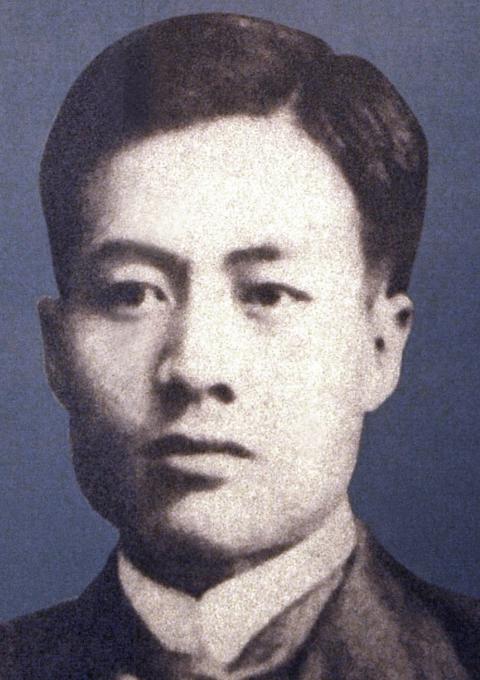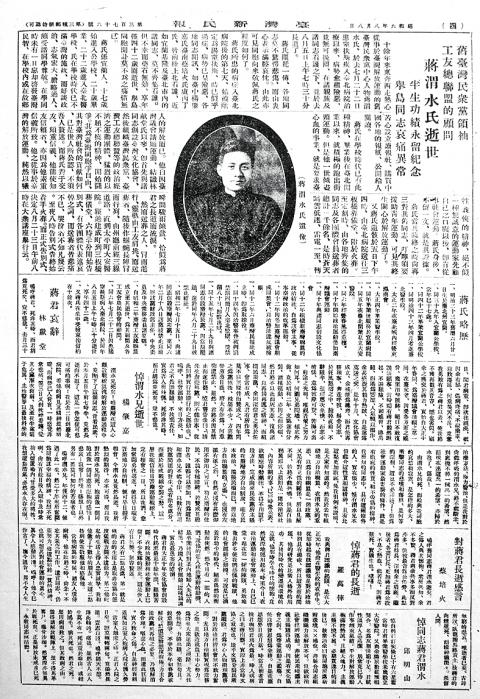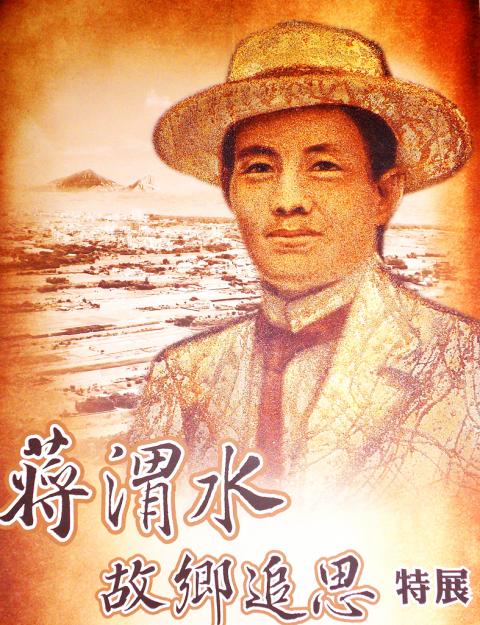On Aug. 5, 1931, Chiang Wei-shui (蔣渭水), an outspoken Taiwanese nationalist during the Japanese colonial era, passed away from typhoid after more than two weeks in the hospital. The man would later be considered a pioneer of Taiwanese democracy and one of the most important leaders of nonviolent resistance against Japanese rule.
The day before his untimely death at age 40, Chiang was still devoted to his cause, encouraging his comrades to “liberate our people.”
On Aug. 23, more than 2,000 people showed up at the funeral ceremony hall, despite warnings by the Japanese colonial government and a strong police presence. Next to Chiang’s photograph hung banners with phrases such as “your spirit will not die” and “liberation fighter.” The police examined and censored parts of the funeral speech, but let the ceremony go on. Right before the procession began, rain started to fall. The crowd, now numbering 5,000, followed Chiang’s hearse undeterred to his final resting place on Taipei’s Dazhi Mountain (大直山).

Taipei Times file photo
FREEDOM FIGHTER
Like many people and events before 1945, Chiang’s name has become mostly forgotten until recent decades. Today, he transcends Taiwan’s political divide, commanding the respect of both the Chinese Nationalist Party (KMT) and the Democratic Progressive Party (DPP).
Chiang, who is often dubbed the Sun Yat-sen of Taiwan (台灣的孫中山), was born in Yilan in 1891, four years before the Japanese took over Taiwan. It was during medical school that he became an outspoken nationalist activist. Armed rebellions against colonial rule mostly ceased after 1915, and intellectuals turned to other ways to fight for autonomy and self-determination.

Photo : Han cheung, Taipei Times
After five years of running his own hospital, Chiang participated in the first petition to the Japanese government for a Taiwanese representative assembly in 1921. Later that year, believing that Taiwanese were suffering from “cultural malnutrition” under Japanese rule, he founded the Taiwan Cultural Association (台灣文化協會) with Lin Hsien-tang (林獻堂), a founder of the Taiwan People’s Party (台灣民眾黨), and others. After convincing the authorities that they wouldn’t participate in political activities, the association held its first meeting with more than 1,000 attendees.
The association aimed to foster a sense of Taiwanese culture and nationalism through seminars, film screenings and other activities. Chiang often criticized the government through the Chinese-language Taiwan Minpao (台灣民報) newspaper, and the Japanese kept a close eye on his activities.
Chiang was arrested and sentenced to four months in jail in 1923, the first of nine subsequent imprisonments.

Taipei Times file photo
When the Cultural Association split into left and right wings in 1927, Chiang founded the Taiwan People’s Party after much government interference, the first legal political party ever in Taiwan. The party adopted Sun’s Three Principles of the People (三民主義) as its political philosophy. Chiang later became involved in worker’s and farmer’s rights.
During this time, his party presented to the League of Nations about the Japanese selling opium in Taiwan and shed light on the Wushe Incident (霧社事件) where more than 600 Aborigines were killed in an armed uprising against the Japanese.
In 1931, the government forcefully dissolved the party, and Chiang died soon after. Taiwanese democracy continued in 1934 when Koo Hsien-jung (辜顯榮) became the first Taiwanese to be named to the Japanese House of Peers. Local assemblies were established in 1935, but after Japan invaded China in 1937, all social movements were banned, and with it the beginning of the imperialist assimilation policy.
Chiang’s idealism is worth noting. He believed that unity in Asia would bring world peace. He wrote that since people in Taiwan were of Chinese descent (中華民族), yet citizens of Japan, they held the key to achieving good relations between the two countries.
OTHER EVENTS THIS WEEK IN HISTORY
The Wulai cable car, the first of its kind in Taiwan, saw its first passengers on Aug. 6, 1967. Each car could carry up to 18 people, and a round trip ticket cost NT$18 per person — not a small price for those days.
The Taipei Fine Arts Museum was established on Aug 8, 1983, on the former site of the United States Taiwan Defense Command headquarters. The command was abandoned in April 1979 following the annulment of the Sino-American Mutual Defense Treaty.
HOLIDAYS
Taiwan is the only country in the world to observe Father’s Day on Aug. 8. This practice originated in 1945 in China, as World War II drew to a close. The following year, prominent Shanghai citizens petitioned the government to make it an official observance to commemorate the fathers who died in the war. The KMT continued the tradition after its retreat to Taiwan, while the Chinese Communist Party adopted the international norm of the third Sunday in June.
Taiwan in Time, a new column about Taiwan’s history that is published every Sunday, spotlights important or interesting events around the nation that have anniversaries this week. Each edition features a main story with other noteworthy tidbits.

Last week writer Wei Lingling (魏玲靈) unloaded a remarkably conventional pro-China column in the Wall Street Journal (“From Bush’s Rebuke to Trump’s Whisper: Navigating a Geopolitical Flashpoint,” Dec 2, 2025). Wei alleged that in a phone call, US President Donald Trump advised Japanese Prime Minister Sanae Takaichi not to provoke the People’s Republic of China (PRC) over Taiwan. Wei’s claim was categorically denied by Japanese government sources. Trump’s call to Takaichi, Wei said, was just like the moment in 2003 when former US president George Bush stood next to former Chinese premier Wen Jia-bao (溫家寶) and criticized former president Chen

As I finally slid into the warm embrace of the hot, clifftop pool, it was a serene moment of reflection. The sound of the river reflected off the cave walls, the white of our camping lights reflected off the dark, shimmering surface of the water, and I reflected on how fortunate I was to be here. After all, the beautiful walk through narrow canyons that had brought us here had been inaccessible for five years — and will be again soon. The day had started at the Huisun Forest Area (惠蓀林場), at the end of Nantou County Route 80, north and east

A six-episode, behind-the-scenes Disney+ docuseries about Taylor Swift’s Eras Tour and Rian Johnson’s third Knives Out movie, Wake Up Dead Man, are some of the new television, films, music and games headed to a device near you. Also among the streaming offerings worth your time this week: Chip and Joanna Gaines take on a big job revamping a small home in the mountains of Colorado, video gamers can skateboard through hell in Sam Eng’s Skate Story and Rob Reiner gets the band back together for Spinal Tap II: The End Continues. MOVIES ■ Rian Johnson’s third Knives Out movie, Wake Up Dead Man

Politics throughout most of the world are viewed through a left/right lens. People from outside Taiwan regularly try to understand politics here through that lens, especially those with strong personal identifications with the left or right in their home countries. It is not helpful. It both misleads and distracts. Taiwan’s politics needs to be understood on its own terms. RISE OF THE DEVELOPMENTAL STATE Arguably, both of the main parties originally leaned left-wing. The Chinese Nationalist Party (KMT) brought together radicals, dissidents and revolutionaries devoted to overthrowing their foreign Manchurian Qing overlords to establish a Chinese republic. Their leader, Sun Yat-sen